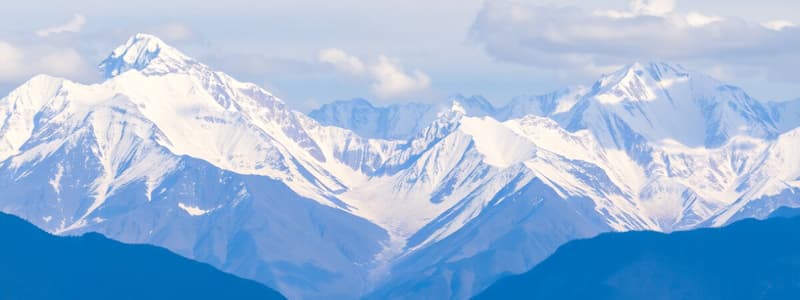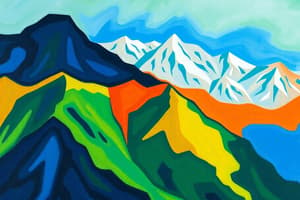Podcast
Questions and Answers
Which of the following ranges is also known as the Tibetan Himalayas?
Which of the following ranges is also known as the Tibetan Himalayas?
- Middle Himalayas
- Greater Himalayas
- Lesser Himalayas
- Trans-Himalayas (correct)
The Siachen Glacier, the largest glacier in India, is located in the Middle Himalayas.
The Siachen Glacier, the largest glacier in India, is located in the Middle Himalayas.
False (B)
Name two rivers that originate from glaciers located in the Greater Himalayas.
Name two rivers that originate from glaciers located in the Greater Himalayas.
Ganga and Yamuna
The youngest and lowest range of the Himalayas, composed of unconsolidated sediments, is known as the _________.
The youngest and lowest range of the Himalayas, composed of unconsolidated sediments, is known as the _________.
Match the following Himalayan ranges with their corresponding descriptions:
Match the following Himalayan ranges with their corresponding descriptions:
Which of the following peaks is located on the border between India and Nepal?
Which of the following peaks is located on the border between India and Nepal?
The Purvanchal Hills are characterized by high elevation peaks similar to the Greater Himalayas.
The Purvanchal Hills are characterized by high elevation peaks similar to the Greater Himalayas.
What is the primary composition of the Shiwalik range that makes it prone to erosion?
What is the primary composition of the Shiwalik range that makes it prone to erosion?
Which range is the Pir Panjal Range a part of?
Which range is the Pir Panjal Range a part of?
Flat, fertile areas between the Lesser Himalayas and Shiwaliks are known as _________.
Flat, fertile areas between the Lesser Himalayas and Shiwaliks are known as _________.
Flashcards
Trans-Himalayas
Trans-Himalayas
Northernmost range, also called the Tibetan Himalayas, lying north of the Great Himalayas.
Greater Himalayas (Himadri)
Greater Himalayas (Himadri)
Highest and most continuous Himalayan range with snow-capped peaks and perennial glaciers.
Middle Himalayas (Himachal Himalayas)
Middle Himalayas (Himachal Himalayas)
Located between Greater Himalayas and Shiwaliks, contains hill stations and valleys.
Lesser Himalayas (Shiwaliks)
Lesser Himalayas (Shiwaliks)
Signup and view all the flashcards
Purvanchal Hills
Purvanchal Hills
Signup and view all the flashcards
K2
K2
Signup and view all the flashcards
Mount Everest
Mount Everest
Signup and view all the flashcards
Siachen Glacier
Siachen Glacier
Signup and view all the flashcards
Pir Panjal Range
Pir Panjal Range
Signup and view all the flashcards
Dun Valleys
Dun Valleys
Signup and view all the flashcards
Study Notes
- The Himalayas are a vast mountain system with several sub-ranges, glaciers, and major peaks.
Major Mountain Ranges
- The Himalayas consist of parallel and adjacent ranges.
Trans-Himalayas (Northernmost)
- Also known as the Tibetan Himalayas
- Lies north of the Great Himalayas, between the Indus and Tsangpo (Brahmaputra) Rivers
- Mostly found in Ladakh and Tibet
Trans-Himalayas Major Ranges:
- Karakoram Range: Highest peak is K2 (8,611 m) located in India/Pakistan
- Ladakh Range: Important for defense purposes with salt deposits
- Zanskar Range: Separates the Indus and Chenab rivers
- Kailash Range: Includes Mt. Kailash, a sacred mountain located in Tibet
Greater Himalayas (Himadri)
- Highest and most continuous range, featuring snow-capped peaks and perennial glaciers
- Contains the world’s tallest peaks
Greater Himalayas Major Peaks:
- Mount Everest: 8,848.86 m, located in Nepal/Tibet
- Kanchenjunga: 8,586 m, located in India/Nepal
- Nanga Parbat: 8,126 m, located in Pakistan.
- Nanda Devi: 7,817 m, located in India.
- Annapurna: 8,091 m, located in Nepal.
- Dhaulagiri: 8,167 m, located in Nepal.
Greater Himalayas Major Glaciers:
- Siachen Glacier: Largest glacier in India, located in Karakoram
- Gangotri Glacier: Source of the River Ganga, located in Uttarakhand
- Yamunotri Glacier: Source of the River Yamuna, located in Uttarakhand
- Milam Glacier: Located in the Kumaon region, Uttarakhand
Middle Himalayas (Himachal Himalayas)
- Located between the Greater Himalayas and Shiwaliks, containing hill stations and valleys
- Average elevation: 3,500 – 4,500 m
Middle Himalayas Major Ranges:
- Pir Panjal Range: Largest range of Middle Himalayas, in J&K and Himachal Pradesh
- Dhauladhar Range: Located in Himachal Pradesh
- Nag Tibba Range: Located in Uttarakhand
- Mahabharat Range: Located in Nepal
Middle Himalayas Important Valleys:
- Kangra Valley
- Kullu Valley
- Kashmir Valley
Lesser Himalayas (Shiwaliks)
- Youngest and lowest range at 900–1,200 m
- Composed of unconsolidated sediments, making it prone to erosion
- Contains Dun valleys, which are flat, fertile areas between the Lesser Himalayas and Shiwaliks
Lesser Himalayas Important Duns:
- Dehradun: Located in Uttarakhand
- Patli Dun
- Kotli Dun
Purvanchal Hills (Eastern Extension)
- Curved hills extending into northeast India, lower in height but densely forested
Purvanchal Hills Major Hills:
- Patkai Hills: Located in Arunachal Pradesh.
- Naga Hills: Located in Nagaland.
- Manipur Hills: Located in Manipur.
- Mizo Hills / Lushai Hills: Located in Mizoram.
- Dafla Hills: Located in Arunachal Pradesh.
- Jaintia, Khasi, and Garo Hills: Located in Meghalaya.
Environmental Significance
- Climatic Barrier: Stops cold winds from Central Asia
- Monsoon Influence: Helps in rainfall across northern India
- Water Source: Origin of major rivers – Ganga, Indus, Brahmaputra
- Biodiversity: Home to rare species like snow leopards, red pandas
- Glacial Reservoirs: Supplies water to millions in South Asia
Mineral Wealth
- Copper, Lead, Zinc: Found in Himachal Pradesh and Uttarakhand
- Gold & Silver: Found in Ladakh and Nepal
- Limestone & Marble: Used for cement and construction
- Gypsum, Mica, Graphite: Found in Lesser Himalayas
Conclusion
- The Himalayas are a lifeline regulating climate, providing water resources, and supporting biodiversity but are vulnerable to natural disasters like earthquakes, landslides, and GLOFs.
Studying That Suits You
Use AI to generate personalized quizzes and flashcards to suit your learning preferences.



